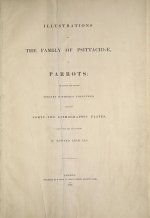Björn Bergenholtz
(former alias "Calalp")

Here´s another tricky Eponym … regarding a certain Mr. Lear!?
There seem to be some confusion, and opposite views, regarding the man behind leari/learii … as in:
● Indigo Macaw Anodorhynchus leari BONAPARTE 1856 a k a "Lear's Macaw"
Any ideas or suggestions?
There are several different claims of whom this Mr. Lear might be, so: What do we know? For sure?
Let´s start with what is mostly considered as the Original description itself (even if it is hard to call it a "description!?): Bonaparte 1856, in: Naumannia : Archiv für die Ornithologie Vorzugsweise Europa's : Organ der Deutsche Ornithologen-Gesellschaft 6. Appendix I (8 Pages). Attached as pdf.
Does this tell us anything whatsoever … The leari is found on the first fold-out-page, top left Column 1; "Subfam. Macrocercinae, 1. Anodorhynchus, Sp. : No. 2. Meager is the word!
What exactly does the cited "hyacinthinus LEAR" (being "Macrocercus hyacinthinus LEAR 1828" I assume) has to do with the whole matter? If the latter does have anything to do with the name leari how does this work with the most often claimed Mr. Lear (as in for example, on HBW Alive)? Born in 1812!
Also compare with what Otto Finsch wrote in 1863, regarding the "Lophochroa Leari" [Syn. Cacatua ducorps PUCHERAN 1853] in his: Naamlijst der in de Diergaarde Levende Papegaaijen ten dienste der bezoekers van den tuin ingerigt. Nederlandsch Tijdschrift voor De Dierkunde 1. VI-XXIV, where he (on page XXIII) says:
Let´s dig into it!
PS. Also (if you do, I do not, understand French) see this link: Original description of Lear's Macaw Anodorhynchus leari by Prince Charles Bonaparte in Iconographie des perroquets (1857-8)
There seem to be some confusion, and opposite views, regarding the man behind leari/learii … as in:
● Indigo Macaw Anodorhynchus leari BONAPARTE 1856 a k a "Lear's Macaw"
Any ideas or suggestions?
There are several different claims of whom this Mr. Lear might be, so: What do we know? For sure?
Let´s start with what is mostly considered as the Original description itself (even if it is hard to call it a "description!?): Bonaparte 1856, in: Naumannia : Archiv für die Ornithologie Vorzugsweise Europa's : Organ der Deutsche Ornithologen-Gesellschaft 6. Appendix I (8 Pages). Attached as pdf.
Does this tell us anything whatsoever … The leari is found on the first fold-out-page, top left Column 1; "Subfam. Macrocercinae, 1. Anodorhynchus, Sp. : No. 2. Meager is the word!
What exactly does the cited "hyacinthinus LEAR" (being "Macrocercus hyacinthinus LEAR 1828" I assume) has to do with the whole matter? If the latter does have anything to do with the name leari how does this work with the most often claimed Mr. Lear (as in for example, on HBW Alive)? Born in 1812!
Also compare with what Otto Finsch wrote in 1863, regarding the "Lophochroa Leari" [Syn. Cacatua ducorps PUCHERAN 1853] in his: Naamlijst der in de Diergaarde Levende Papegaaijen ten dienste der bezoekers van den tuin ingerigt. Nederlandsch Tijdschrift voor De Dierkunde 1. VI-XXIV, where he (on page XXIII) says:
Link to full volume (here)”Eene nieuwe soort, die zich aan de voorgaande aansluit, doch door het ontbreken van een rood gezigt en den veel duidelijker blaauwachtigen oogkring dadelijk onderkennen laat. Vaderland onbekend. Ter eera van den Heer LEAR genoemd.”
Let´s dig into it!
PS. Also (if you do, I do not, understand French) see this link: Original description of Lear's Macaw Anodorhynchus leari by Prince Charles Bonaparte in Iconographie des perroquets (1857-8)




